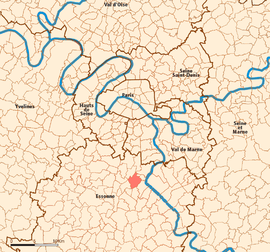Savigny-sur-Orge | |
|---|---|
 The town hall in Savigny-sur-Orge | |
 Location (in red) within Paris inner and outer suburbs | |
| Coordinates: 48°40′47″N 2°20′45″E / 48.6797°N 2.3457°E | |
| Country | France |
| Region | Île-de-France |
| Department | Essonne |
| Arrondissement | Palaiseau |
| Canton | Savigny-sur-Orge |
| Intercommunality | Grand Paris |
| Government | |
| • Mayor (2021–2026) | Alexis Teillet[1] |
| Area 1 | 6.97 km2 (2.69 sq mi) |
| Population (2021)[2] | 37,371 |
| • Density | 5,400/km2 (14,000/sq mi) |
| Time zone | UTC+01:00 (CET) |
| • Summer (DST) | UTC+02:00 (CEST) |
| INSEE/Postal code | 91589 /91600 |
| Elevation | 33–99 m (108–325 ft) |
| 1 French Land Register data, which excludes lakes, ponds, glaciers > 1 km2 (0.386 sq mi or 247 acres) and river estuaries. | |
Savigny-sur-Orge (French pronunciation: [saviɲi syʁ ɔʁʒ] , literally Savigny upon Orge) is a commune in the southern suburbs of Paris, France. It is located 19.1 km (11.9 mi) from the center of Paris in the département of Essonne.
During the 2005 civil unrest in France, Savigny was the first city to implement a curfew. It is home to the Jean-Baptiste Corot High School, a twelfth-century château converted into a school and the former property of Marshal Davout.
Inhabitants of Savigny-sur-Orge are known as Saviniens. Writer Patrick Erouart-Siad (born 1955 in Savigny) won the 1993 Prix Ève Delacroix of the Académie française.
Louis-Nicolas Davout, a military commander under Napoleon, died in Savigny-sur-Orge, and one of the squares bears his name.
- ^ "Répertoire national des élus: les maires". data.gouv.fr, Plateforme ouverte des données publiques françaises (in French). 1 February 2022.
- ^ "Populations légales 2021" (in French). The National Institute of Statistics and Economic Studies. 28 December 2023.



